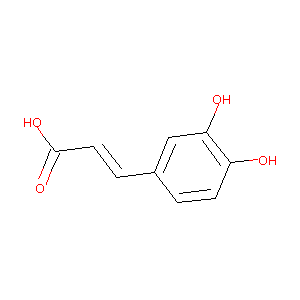Drug Information
| Drug General Information | Top | |||
|---|---|---|---|---|
| Drug ID |
D0V9EN
|
|||
| Former ID |
DNC002964
|
|||
| Drug Name |
3,4-Dihydroxycinnamic Acid
|
|||
| Synonyms |
Caffeic acid; caffeic acid; 3,4-Dihydroxycinnamic acid; 331-39-5; 3-(3,4-dihydroxyphenyl)acrylic acid; 501-16-6; (E)-3-(3,4-dihydroxyphenyl)acrylic acid; 3,4-Dihydroxybenzeneacrylic acid; (2E)-3-(3,4-dihydroxyphenyl)prop-2-enoic acid; trans-caffeic acid; trans-Caffeate; 3,4-Dihydroxy-trans-cinnamate; 2-Propenoic acid, 3-(3,4-dihydroxyphenyl)-; Cinnamic acid, 3,4-dihydroxy-; 3-(3,4-Dihydroxyphenyl)propenoic acid; UNII-U2S3A33KVM; 3-(3,4-Dihydroxyphenyl)-2-propenoic acid; 4-(2-Carboxyethenyl)-1,2-dihydroxybenzene
Click to Show/Hide
|
|||
| Drug Type |
Small molecular drug
|
|||
| Indication | Thrombocytopenia [ICD-11: 3B64] | Phase 4 | [1] | |
| Structure |
 |
Download2D MOL |
||
| Formula |
C9H8O4
|
|||
| Canonical SMILES |
C1=CC(=C(C=C1C=CC(=O)O)O)O
|
|||
| InChI |
1S/C9H8O4/c10-7-3-1-6(5-8(7)11)2-4-9(12)13/h1-5,10-11H,(H,12,13)/b4-2+
|
|||
| InChIKey |
QAIPRVGONGVQAS-DUXPYHPUSA-N
|
|||
| CAS Number |
CAS 331-39-5
|
|||
| PubChem Compound ID | ||||
| PubChem Substance ID |
4422, 4652, 106262, 491233, 598027, 611234, 855772, 3132907, 8001577, 8034051, 8145667, 9287032, 10518882, 11537800, 14718166, 15171314, 17404771, 22394958, 22395875, 24278290, 24881776, 24881777, 26612575, 26679411, 26746990, 26751505, 26758358, 29203902, 33749646, 46504491, 48413363, 48422454, 49699041, 49703794, 49747047, 49855355, 50104061, 50104062, 50104063, 50104064, 50104065, 53777314, 53787916, 56422203, 57408588, 57651712, 58034488, 74966461, 81040420, 81091163
|
|||
| ChEBI ID |
CHEBI:16433
|
|||
| Interaction between the Drug and Microbe | Top | |||
|---|---|---|---|---|
| The Metabolism of Drug Affected by Studied Microbe(s) | ||||
| The Order in the Taxonomic Hierarchy of the following Microbe(s): Gut microbiota | ||||
| Studied Microbe: Gut microbiota unspecific | [2] | |||
| Metabolic Reaction | Reduction and dehydoxylation | |||
| Description | Caffeic acid can be metabolized by gut microbiota through reduction and dehydoxylation. | |||
| Target and Pathway | Top | |||
|---|---|---|---|---|
| Target(s) | Arachidonate 5-lipoxygenase (5-LOX) | Target Info | Inhibitor | [3], [4], [5] |
| Macrophage migration inhibitory factor (MIF) | Target Info | Inhibitor | [6] | |
| BioCyc | Aspirin-triggered lipoxin biosynthesis | |||
| Resolvin D biosynthesis | ||||
| Leukotriene biosynthesis | ||||
| Lipoxin biosynthesis | ||||
| Aspirin triggered resolvin D biosynthesis | ||||
| Aspirin triggered resolvin E biosynthesis | ||||
| KEGG Pathway | Tyrosine metabolism | |||
| Phenylalanine metabolism | ||||
| Arachidonic acid metabolism | ||||
| Metabolic pathways | ||||
| Serotonergic synapse | ||||
| Ovarian steroidogenesis | ||||
| Toxoplasmosis | ||||
| NetPath Pathway | IL4 Signaling Pathway | |||
| Pathwhiz Pathway | Tyrosine Metabolism | |||
| Arachidonic Acid Metabolism | ||||
| WikiPathways | Spinal Cord Injury | |||
| Adipogenesis | ||||
| Vitamin D Receptor Pathway | ||||
| Arachidonic acid metabolism | ||||
| Eicosanoid Synthesis | ||||
| Selenium Micronutrient Network | ||||
| References | Top | |||
|---|---|---|---|---|
| REF 1 | ClinicalTrials.gov (NCT02556814) Caffeic Acid Combining High-dose Dexamethasone in Management of ITP. U.S. National Institutes of Health. | |||
| REF 2 | Gut Reactions: Breaking Down Xenobiotic-Microbiome Interactions. Pharmacol Rev. 2019 Apr;71(2):198-224. | |||
| REF 3 | Phenidone protects the nigral dopaminergic neurons from LPS-induced neurotoxicity. Neurosci Lett. 2008 Nov 7;445(1):1-6. | |||
| REF 4 | Protection of mouse brain from aluminum-induced damage by caffeic acid. CNS Neurosci Ther. 2008 Spring;14(1):10-6. | |||
| REF 5 | Involvement of the 5-lipoxygenase pathway in the neurotoxicity of the prion peptide PrP106-126. J Neurosci Res. 2001 Sep 15;65(6):565-72. | |||
| REF 6 | How many drug targets are there Nat Rev Drug Discov. 2006 Dec;5(12):993-6. | |||
If You Find Any Error in Data or Bug in Web Service, Please Kindly Report It to Dr. Zhou and Dr. Zhang.

